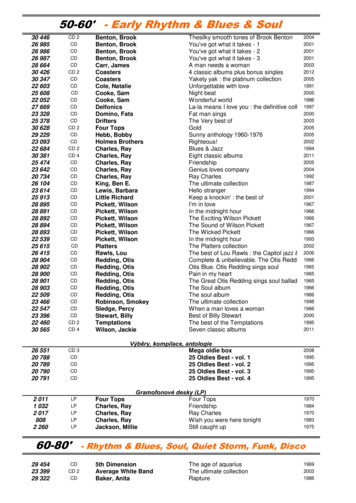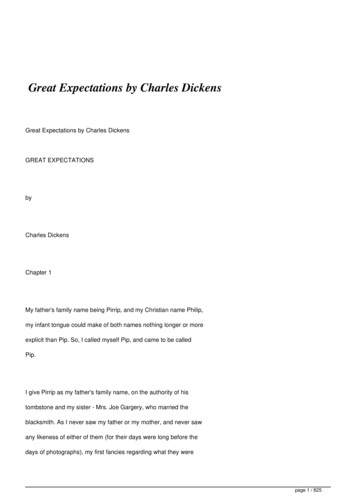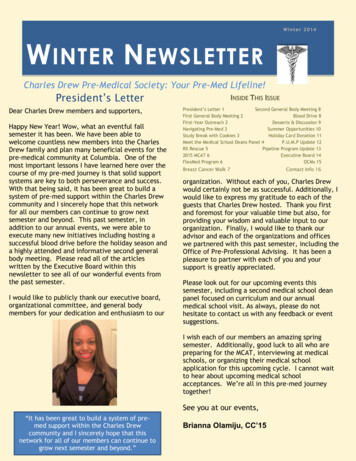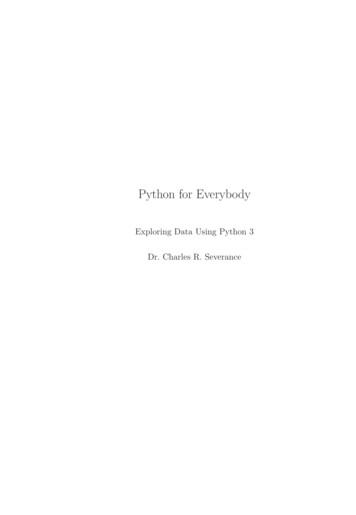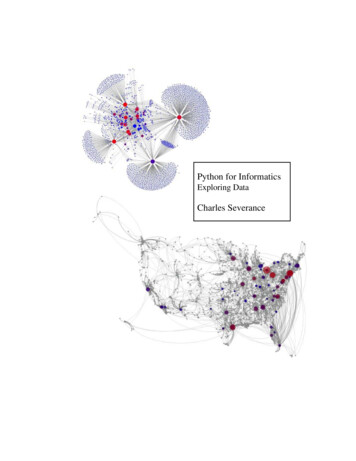
Transcription
Python for InformaticsExploring DataCharles Severance
Python for InformaticsExploring InformationVersion 0.0.3Charles Severance
Copyright 2009, 2010 Charles Severance.Printing history:December 2009: Begin to produce Python for Informatics: Exploring Information by re-mixingThink Python: How to Think Like a Computer ScientistJune 2008: Major revision, changed title to Think Python: How to Think Like a Computer Scientist.August 2007: Major revision, changed title to How to Think Like a (Python) Programmer.April 2002: First edition of How to Think Like a Computer Scientist.This work is licensed under a Creative Commons Attribution-Share Alike 3.0 Unported License. Thislicense is available at creativecommons.org/licenses/by-sa/3.0/.The original form of this book is LATEX source code. Compiling this LATEX source has the effectof generating a device-independent representation of a textbook, which can be converted to otherformats and printed.The LATEX source for the Think Python: How to Think Like a Computer Scientist version of this bookis available from http://www.thinkpython.com.The LATEX source for the Python for Informatics: Exploring Information version of the book isavailable (for the moment) from /pyinf/.The cover images were provided by Dr. Lada Adamic and are used with permission.
PrefacePython for Informatics: Remixing an Open BookIt is quite natural for academics who are continuously told to “publish or perish” to wantto always create something from scratch that is their own fresh creation. This book isan experiment in not starting from scratch, but instead “re-mixing” the book titled ThinkPython: How to Think Like a Computer Scientist written by Allen B. Downey, Jeff Elknerand others.In December of 2009, I was preparing to teach SI502 - Networked Programming at theUniversity of Michigan for the fifth semester in a row and decided it was time to write aPython textbook that focused on exploring data instead of understanding algorithms and abstractions. My goal in SI502 is to teach people life-long data handling skills using Python.Few of my students were planning to be be professional computer programmers. Instead,they planned be librarians, managers, lawyers, biologists, economists, etc. who happenedto want to skillfully use technology in their chosen field.I never seemed to find the perfect data-oriented Python book for my course so I set outto write just such a book. Luckily at a faculty meeting three weeks before I was about tostart my new book from scratch over the holiday break, Dr. Atul Prakash showed me theThink Python book which he had used to teach his Python course that semester. It is awell-written Computer Science text with a focus on short, direct explanations and ease oflearning.As the copyright holder of Think Python, Allen has given me permission to change thebook’s license from the GNU Free Documentation License to the more recent CreativeCommons Attribution — Share Alike license. This follows a general shift in open documentation licenses moving from the GFDL to the CC-BY-SA (i.e. Wikipedia). Usingthe CC-BY-SA license maintains the book’s strong copyleft tradition while making it evenmore straightforward for new authors to reuse this material as they see fit.I expect that by the time I am done with Python for Informatics over fifty percent of thebook will be new. The overall structure will be changed to get to doing data analysisproblems as quickly as possible and have a series of running examples and exercises aboutdata analysis. Then I will add chapters on regular expressions, data visualization, workingwith spreadsheet data, structured query language using SQLite, web scraping, and callingREST-based Application Program Interfaces.
viChapter 0. PrefaceThe ultimate goal in the shift from a Computer Science to an Informatics focus is to pulltopics into the first programming class that can be applied even if one chooses not to become a professional programmer.What is interesting even with this change of focus is how much of the original Think Pythonbook material is directly relevant to this book and how much will fit right into Python forInformatics with virtually no change.By starting with the Think Python book, I don’t have to write the basic descriptions of thePython language or how to debug programs and instead focus on the topical material thatis the value-add of Python for Informatics.Students who find this book interesting and want to further explore a career as a professional programmer should probably look at the Think Python book. Because there is a lotof overlap between the two books, you will quickly pick up skills in the additional areasof Computer Science which are covered in Think Python. And given that the books have asimilar writing style and at times have identical text and examples, you should be able topick up these new topics with a minimum of effort.I hope that this book serves an example of why open materials are so important to the futureof education, and want to thank Allen B. Downey and Cambridge University Press for theirforward looking decision to make the book available under an open Copyright. I hope theyare pleased with the results of my efforts and I hope that you the reader are pleased withour collective efforts.Charles Severancewww.dr-chuck.comDecember 19, 2009Charles Severance is a Clinical Assistant Professor at the University of Michigan Schoolof Information.Draft Version InstructionsThe copy of this book you are looking at is currently a draft and still in development. Thegeneral roadmap for the rest of the development book is as follows: Teach SI502 - Networked Programming at University of Michigan Winter 2010. Thefirst 10 chapters of the book will be used for the first four weeks of the course. Atleast three more chapters will be written for SI502 and distributed during the semesterthat line up with the topics in the second half of SI502 (Networked Programming,Databases, and Using Web Services). There are four more chapters planned at some point (Advanced Functions, Regular Expressions, Automating Common Tasks, and Visualizing data). These are notcurrently in the scope of SI502 for Winter 2010.Like all books being written and used in a course at the same time, student feedback isessential to producing a strong book. So I hope that students will look at the book and
viihelp me find simple errors, places where ideas jump too fast, improvements in the glossary,debugging, and exercises in each chapter.You can also send comments to csev (at) umich.edu at any time.Thanks in advance for your patience and assistance.Preface for “Think Python”The strange history of “Think Python”(Allen B. Downey)In January 1999 I was preparing to teach an introductory programming class in Java. I hadtaught it three times and I was getting frustrated. The failure rate in the class was too highand, even for students who succeeded, the overall level of achievement was too low.One of the problems I saw was the books. They were too big, with too much unnecessarydetail about Java, and not enough high-level guidance about how to program. And they allsuffered from the trap door effect: they would start out easy, proceed gradually, and thensomewhere around Chapter 5 the bottom would fall out. The students would get too muchnew material, too fast, and I would spend the rest of the semester picking up the pieces.Two weeks before the first day of classes, I decided to write my own book. My goals were: Keep it short. It is better for students to read 10 pages than not read 50 pages. Be careful with vocabulary. I tried to minimize the jargon and define each term atfirst use. Build gradually. To avoid trap doors, I took the most difficult topics and split theminto a series of small steps. Focus on programming, not the programming language. I included the minimumuseful subset of Java and left out the rest.I needed a title, so on a whim I chose How to Think Like a Computer Scientist.My first version was rough, but it worked. Students did the reading, and they understoodenough that I could spend class time on the hard topics, the interesting topics and (mostimportant) letting the students practice.I released the book under the GNU Free Documentation License, which allows users tocopy, modify, and distribute the book.What happened next is the cool part. Jeff Elkner, a high school teacher in Virginia, adoptedmy book and translated it into Python. He sent me a copy of his translation, and I had theunusual experience of learning Python by reading my own book.Jeff and I revised the book, incorporated a case study by Chris Meyers, and in 2001 wereleased How to Think Like a Computer Scientist: Learning with Python, also under the
viiiChapter 0. PrefaceGNU Free Documentation License. As Green Tea Press, I published the book and startedselling hard copies through Amazon.com and college book stores. Other books from GreenTea Press are available at greenteapress.com.In 2003 I started teaching at Olin College and I got to teach Python for the first time. Thecontrast with Java was striking. Students struggled less, learned more, worked on moreinteresting projects, and generally had a lot more fun.Over the last five years I have continued to develop the book, correcting errors, improvingsome of the examples and adding material, especially exercises. In 2008 I started work ona major revision—at the same time, I was contacted by an editor at Cambridge UniversityPress who was interested in publishing the next edition. Good timing!I hope you enjoy working with this book, and that it helps you learn to program and think,at least a little bit, like a computer scientist.Acknowledgements for “Think Python”(Allen B. Downey)First and most importantly, I thank Jeff Elkner, who translated my Java book into Python,which got this project started and introduced me to what has turned out to be my favoritelanguage.I also thank Chris Meyers, who contributed several sections to How to Think Like a Computer Scientist.And I thank the Free Software Foundation for developing the GNU Free DocumentationLicense, which helped make my collaboration with Jeff and Chris possible.I also thank the editors at Lulu who worked on How to Think Like a Computer Scientist.I thank all the students who worked with earlier versions of this book and all the contributors (listed in an Appendix) who sent in corrections and suggestions.And I thank my wife, Lisa, for her work on this book, and Green Tea Press, and everythingelse, too.Allen B. DowneyNeedham MAAllen Downey is an Associate Professor of Computer Science at the Franklin W. OlinCollege of Engineering.
ContentsPrefacev1 Why should you learn to write programs?11.1Creativity and motivation . . . . . . . . . . . . . . . . . . . . . . . . . .21.2Computer hardware architecture . . . . . . . . . . . . . . . . . . . . . .31.3Understanding programming . . . . . . . . . . . . . . . . . . . . . . . .41.4The Python programming language . . . . . . . . . . . . . . . . . . . . .51.5What is a program? . . . . . . . . . . . . . . . . . . . . . . . . . . . . .61.6What is debugging? . . . . . . . . . . . . . . . . . . . . . . . . . . . . .71.7Building “sentences” in Python . . . . . . . . . . . . . . . . . . . . . . .91.8The first program . . . . . . . . . . . . . . . . . . . . . . . . . . . . . . 111.9Debugging . . . . . . . . . . . . . . . . . . . . . . . . . . . . . . . . . . 111.10Glossary . . . . . . . . . . . . . . . . . . . . . . . . . . . . . . . . . . . 121.11Exercises . . . . . . . . . . . . . . . . . . . . . . . . . . . . . . . . . . 132 Variables, expressions and statements152.1Values and types . . . . . . . . . . . . . . . . . . . . . . . . . . . . . . . 152.2Variables . . . . . . . . . . . . . . . . . . . . . . . . . . . . . . . . . . . 162.3Variable names and keywords . . . . . . . . . . . . . . . . . . . . . . . . 172.4Statements . . . . . . . . . . . . . . . . . . . . . . . . . . . . . . . . . . 182.5Operators and operands . . . . . . . . . . . . . . . . . . . . . . . . . . . 182.6Expressions . . . . . . . . . . . . . . . . . . . . . . . . . . . . . . . . . 19
xContents2.7Order of operations . . . . . . . . . . . . . . . . . . . . . . . . . . . . . 202.8Modulus operator . . . . . . . . . . . . . . . . . . . . . . . . . . . . . . 202.9String operations . . . . . . . . . . . . . . . . . . . . . . . . . . . . . . 212.10Asking the user for input . . . . . . . . . . . . . . . . . . . . . . . . . . 212.11Comments . . . . . . . . . . . . . . . . . . . . . . . . . . . . . . . . . . 222.12Choosing mnemonic variable names . . . . . . . . . . . . . . . . . . . . 232.13Debugging . . . . . . . . . . . . . . . . . . . . . . . . . . . . . . . . . . 242.14Glossary . . . . . . . . . . . . . . . . . . . . . . . . . . . . . . . . . . . 252.15Exercises . . . . . . . . . . . . . . . . . . . . . . . . . . . . . . . . . . 263 Conditional execution293.1Boolean expressions . . . . . . . . . . . . . . . . . . . . . . . . . . . . . 293.2Logical operators . . . . . . . . . . . . . . . . . . . . . . . . . . . . . . 303.3Conditional execution . . . . . . . . . . . . . . . . . . . . . . . . . . . . 303.4Alternative execution . . . . . . . . . . . . . . . . . . . . . . . . . . . . 313.5Chained conditionals . . . . . . . . . . . . . . . . . . . . . . . . . . . . 313.6Nested conditionals . . . . . . . . . . . . . . . . . . . . . . . . . . . . . 323.7Catching exceptions using try and except . . . . . . . . . . . . . . . . . . 323.8Short circuit evaluation of logical expressions . . . . . . . . . . . . . . . 343.9Debugging . . . . . . . . . . . . . . . . . . . . . . . . . . . . . . . . . . 353.10Glossary . . . . . . . . . . . . . . . . . . . . . . . . . . . . . . . . . . . 363.11Exercises . . . . . . . . . . . . . . . . . . . . . . . . . . . . . . . . . . 374 Functions394.1Function calls . . . . . . . . . . . . . . . . . . . . . . . . . . . . . . . . 394.2Built-in functions . . . . . . . . . . . . . . . . . . . . . . . . . . . . . . 394.3Type conversion functions . . . . . . . . . . . . . . . . . . . . . . . . . 404.4Random numbers . . . . . . . . . . . . . . . . . . . . . . . . . . . . . . 414.5Optional parameters . . . . . . . . . . . . . . . . . . . . . . . . . . . . . 414.6Glossary . . . . . . . . . . . . . . . . . . . . . . . . . . . . . . . . . . . 42
Contentsxi4.7Math functions . . . . . . . . . . . . . . . . . . . . . . . . . . . . . . . 424.8Adding new functions . . . . . . . . . . . . . . . . . . . . . . . . . . . . 434.9Definitions and uses . . . . . . . . . . . . . . . . . . . . . . . . . . . . . 454.10Flow of execution . . . . . . . . . . . . . . . . . . . . . . . . . . . . . . 454.11Parameters and arguments . . . . . . . . . . . . . . . . . . . . . . . . . 464.12Fruitful functions and void functions . . . . . . . . . . . . . . . . . . . . 474.13Why functions? . . . . . . . . . . . . . . . . . . . . . . . . . . . . . . . 484.14Debugging . . . . . . . . . . . . . . . . . . . . . . . . . . . . . . . . . . 494.15Glossary . . . . . . . . . . . . . . . . . . . . . . . . . . . . . . . . . . . 494.16Exercises . . . . . . . . . . . . . . . . . . . . . . . . . . . . . . . . . . 505 Iteration515.1Updating variables . . . . . . . . . . . . . . . . . . . . . . . . . . . . . 515.2The while statement . . . . . . . . . . . . . . . . . . . . . . . . . . . . 515.3Infinite loops . . . . . . . . . . . . . . . . . . . . . . . . . . . . . . . . 525.4“Infinite loops” and break . . . . . . . . . . . . . . . . . . . . . . . . . 535.5Finishing iterations with continue . . . . . . . . . . . . . . . . . . . . . 555.6Definite loops using for . . . . . . . . . . . . . . . . . . . . . . . . . . 555.7Loop patterns . . . . . . . . . . . . . . . . . . . . . . . . . . . . . . . . 565.8Debugging . . . . . . . . . . . . . . . . . . . . . . . . . . . . . . . . . . 595.9Glossary . . . . . . . . . . . . . . . . . . . . . . . . . . . . . . . . . . . 595.10Exercises . . . . . . . . . . . . . . . . . . . . . . . . . . . . . . . . . . 606 Strings616.1A string is a sequence . . . . . . . . . . . . . . . . . . . . . . . . . . . . 616.2Getting the length of a string using len . . . . . . . . . . . . . . . . . . . 626.3Traversal through a string with a for loop . . . . . . . . . . . . . . . . . 626.4String slices . . . . . . . . . . . . . . . . . . . . . . . . . . . . . . . . . 636.5Strings are immutable . . . . . . . . . . . . . . . . . . . . . . . . . . . . 646.6Searching . . . . . . . . . . . . . . . . . . . . . . . . . . . . . . . . . . 65
xiiContents6.7Looping and counting . . . . . . . . . . . . . . . . . . . . . . . . . . . . 656.8The in operator . . . . . . . . . . . . . . . . . . . . . . . . . . . . . . . 666.9String comparison . . . . . . . . . . . . . . . . . . . . . . . . . . . . . . 666.10string methods . . . . . . . . . . . . . . . . . . . . . . . . . . . . . . . 666.11Parsing strings . . . . . . . . . . . . . . . . . . . . . . . . . . . . . . . . 696.12Format operator . . . . . . . . . . . . . . . . . . . . . . . . . . . . . . . 696.13Debugging . . . . . . . . . . . . . . . . . . . . . . . . . . . . . . . . . . 706.14Glossary . . . . . . . . . . . . . . . . . . . . . . . . . . . . . . . . . . . 736.15Exercises . . . . . . . . . . . . . . . . . . . . . . . . . . . . . . . . . . 747 Files777.1Persistence . . . . . . . . . . . . . . . . . . . . . . . . . . . . . . . . . . 777.2Opening files . . . . . . . . . . . . . . . . . . . . . . . . . . . . . . . . 787.3Text files and lines . . . . . . . . . . . . . . . . . . . . . . . . . . . . . . 787.4Reading files7.5Searching through a file . . . . . . . . . . . . . . . . . . . . . . . . . . . 817.6Letting the user choose the file name . . . . . . . . . . . . . . . . . . . . 837.7Using try, catch, and open . . . . . . . . . . . . . . . . . . . . . . . 837.8Writing files . . . . . . . . . . . . . . . . . . . . . . . . . . . . . . . . . 857.9Debugging . . . . . . . . . . . . . . . . . . . . . . . . . . . . . . . . . . 867.10Glossary . . . . . . . . . . . . . . . . . . . . . . . . . . . . . . . . . . . 867.11Exercises . . . . . . . . . . . . . . . . . . . . . . . . . . . . . . . . . . 868 Lists. . . . . . . . . . . . . . . . . . . . . . . . . . . . . . . . 80898.1A list is a sequence . . . . . . . . . . . . . . . . . . . . . . . . . . . . . 898.2Lists are mutable . . . . . . . . . . . . . . . . . . . . . . . . . . . . . . 908.3Traversing a list . . . . . . . . . . . . . . . . . . . . . . . . . . . . . . . 918.4List operations . . . . . . . . . . . . . . . . . . . . . . . . . . . . . . . . 918.5List slices . . . . . . . . . . . . . . . . . . . . . . . . . . . . . . . . . . 928.6List methods . . . . . . . . . . . . . . . . . . . . . . . . . . . . . . . . . 92
Contentsxiii8.7Deleting elements . . . . . . . . . . . . . . . . . . . . . . . . . . . . . . 938.8Lists and strings . . . . . . . . . . . . . . . . . . . . . . . . . . . . . . . 948.9Parsing lines . . . . . . . . . . . . . . . . . . . . . . . . . . . . . . . . . 958.10Objects and values . . . . . . . . . . . . . . . . . . . . . . . . . . . . . 968.11Aliasing . . . . . . . . . . . . . . . . . . . . . . . . . . . . . . . . . . . 978.12List arguments . . . . . . . . . . . . . . . . . . . . . . . . . . . . . . . . 978.13Debugging . . . . . . . . . . . . . . . . . . . . . . . . . . . . . . . . . . 998.14Glossary . . . . . . . . . . . . . . . . . . . . . . . . . . . . . . . . . . . 1028.15Exercises . . . . . . . . . . . . . . . . . . . . . . . . . . . . . . . . . . 1039 Dictionaries1059.1Dictionary as a set of counters . . . . . . . . . . . . . . . . . . . . . . . 1079.2Dictionaries and files . . . . . . . . . . . . . . . . . . . . . . . . . . . . 1089.3Looping and dictionaries . . . . . . . . . . . . . . . . . . . . . . . . . . 1099.4Advanced text parsing . . . . . . . . . . . . . . . . . . . . . . . . . . . . 1109.5Debugging . . . . . . . . . . . . . . . . . . . . . . . . . . . . . . . . . . 1129.6Glossary . . . . . . . . . . . . . . . . . . . . . . . . . . . . . . . . . . . 1139.7Exercises . . . . . . . . . . . . . . . . . . . . . . . . . . . . . . . . . . 11310 Tuples11510.1Tuples are immutable . . . . . . . . . . . . . . . . . . . . . . . . . . . . 11510.2Comparing tuples . . . . . . . . . . . . . . . . . . . . . . . . . . . . . . 11610.3Tuple assignment . . . . . . . . . . . . . . . . . . . . . . . . . . . . . . 11710.4Dictionaries and tuples . . . . . . . . . . . . . . . . . . . . . . . . . . . 11910.5Multiple assignment with dictionaries . . . . . . . . . . . . . . . . . . . 11910.6The most common words . . . . . . . . . . . . . . . . . . . . . . . . . . 12010.7Using tuples as keys in dictionaries . . . . . . . . . . . . . . . . . . . . . 12110.8Sequences: strings, lists, and tuples–Oh My! . . . . . . . . . . . . . . . . 12210.9Debugging . . . . . . . . . . . . . . . . . . . . . . . . . . . . . . . . . . 12310.10 Glossary . . . . . . . . . . . . . . . . . . . . . . . . . . . . . . . . . . . 12410.11 Exercises . . . . . . . . . . . . . . . . . . . . . . . . . . . . . . . . . . 125
xivContents11 Automating common tasks on your computer12711.1File names and paths . . . . . . . . . . . . . . . . . . . . . . . . . . . . 12711.2Example: Cleaning up a photo directory . . . . . . . . . . . . . . . . . . 12811.3Command line arguments . . . . . . . . . . . . . . . . . . . . . . . . . . 13311.4Pipes . . . . . . . . . . . . . . . . . . . . . . . . . . . . . . . . . . . . . 13511.5Glossary . . . . . . . . . . . . . . . . . . . . . . . . . . . . . . . . . . . 13511.6Exercises . . . . . . . . . . . . . . . . . . . . . . . . . . . . . . . . . . 13612 Networked programs13912.1HyperText Transport Protocol - HTTP . . . . . . . . . . . . . . . . . . . 13912.2The World’s Simplest Web Browser . . . . . . . . . . . . . . . . . . . . 14012.3Retrieving web pages with urllib . . . . . . . . . . . . . . . . . . . . . 14112.4Parsing HTML and scraping the web . . . . . . . . . . . . . . . . . . . . 14212.5Glossary . . . . . . . . . . . . . . . . . . . . . . . . . . . . . . . . . . . 14412.6Exercises . . . . . . . . . . . . . . . . . . . . . . . . . . . . . . . . . . 14513 Using Web Services14713.1eXtensible Markup Language - XML . . . . . . . . . . . . . . . . . . . . 14713.2Parsing XML . . . . . . . . . . . . . . . . . . . . . . . . . . . . . . . . 14713.3Looping through nodes . . . . . . . . . . . . . . . . . . . . . . . . . . . 14813.4Application Programming Interfaces (API) . . . . . . . . . . . . . . . . . 14913.5Twitter web services . . . . . . . . . . . . . . . . . . . . . . . . . . . . 15013.6Handling XML data from an API . . . . . . . . . . . . . . . . . . . . . . 15213.7Glossary . . . . . . . . . . . . . . . . . . . . . . . . . . . . . . . . . . . 15313.8Exercises . . . . . . . . . . . . . . . . . . . . . . . . . . . . . . . . . . 15414 Using databases and Structured Query Language (SQL)15514.1What is a database? . . . . . . . . . . . . . . . . . . . . . . . . . . . . . 15514.2Database concepts . . . . . . . . . . . . . . . . . . . . . . . . . . . . . . 15514.3SQLite Database Browser . . . . . . . . . . . . . . . . . . . . . . . . . . 156
Contentsxv14.4Creating a database table . . . . . . . . . . . . . . . . . . . . . . . . . . 15614.5Structured Query Language (SQL) summary . . . . . . . . . . . . . . . . 15914.6Spidering Twitter using a database . . . . . . . . . . . . . . . . . . . . . 16014.7Basic data modeling . . . . . . . . . . . . . . . . . . . . . . . . . . . . . 16514.8Programming with multiple tables . . . . . . . . . . . . . . . . . . . . . 16614.9Three kinds of keys . . . . . . . . . . . . . . . . . . . . . . . . . . . . . 17114.10 Using JOIN to retrieve data . . . . . . . . . . . . . . . . . . . . . . . . . 17214.11 Summary . . . . . . . . . . . . . . . . . . . . . . . . . . . . . . . . . . 17414.12 Debugging . . . . . . . . . . . . . . . . . . . . . . . . . . . . . . . . . . 17414.13 Glossary . . . . . . . . . . . . . . . . . . . . . . . . . . . . . . . . . . . 17515 Advanced functions17715.1Return values . . . . . . . . . . . . . . . . . . . . . . . . . . . . . . . . 17715.2Tuples as return values . . . . . . . . . . . . . . . . . . . . . . . . . . . 17815.3Variable-length argument tuples . . . . . . . . . . . . . . . . . . . . . . 17915.4Variables and parameters are local . . . . . . . . . . . . . . . . . . . . . 18015.5Global variables . . . . . . . . . . . . . . . . . . . . . . . . . . . . . . . 18015.6Incremental development . . . . . . . . . . . . . . . . . . . . . . . . . . 18215.7Composition . . . . . . . . . . . . . . . . . . . . . . . . . . . . . . . . . 18415.8Stack diagrams . . . . . . . . . . . . . . . . . . . . . . . . . . . . . . . 18515.9Boolean functions . . . . . . . . . . . . . . . . . . . . . . . . . . . . . . 18615.10 Optional parameters . . . . . . . . . . . . . . . . . . . . . . . . . . . . . 18615.11 Debugging . . . . . . . . . . . . . . . . . . . . . . . . . . . . . . . . . . 18715.12 Glossary . . . . . . . . . . . . . . . . . . . . . . . . . . . . . . . . . . . 18815.13 Exercises . . . . . . . . . . . . . . . . . . . . . . . . . . . . . . . . . . 189A Debugging191A.1Syntax errors . . . . . . . . . . . . . . . . . . . . . . . . . . . . . . . . 191A.2Runtime errors . . . . . . . . . . . . . . . . . . . . . . . . . . . . . . . 193A.3Semantic errors . . . . . . . . . . . . . . . . . . . . . . . . . . . . . . . 196B Contributor List199
xviContents
Chapter 1Why should you learn to writeprograms?Writing programs (or programming) is a very creative and rewarding activity. You canwrite programs for many reasons ranging from making your living to solving a difficultdata analysis problem to having fun to helping someone else solve a problem. This bookassumes that everyone needs to know how to program and that once you know how toprogram, you will figure out what you want to do with your newfound skills.We are surrounded in our daily lives with computers ranging from laptops to cell phones.We can think of these computers as our “personal assistants” who can take care of manythings on our behalf. The hardware in our current-day computers is essentially built tocontinuously ask us the question, “What would you like me to do ext?WhatNext?PDAProgrammers add and operating system and a set of applications to the hardware and weend up with a Personal Digital Assistant that is quite helpful and calable of helping manydifferent things.Our computers are fast and have vast amounts of memory and could be very helpful to usif we only knew the language to speak to explain to the computer what we would like it to“do next”. If we knew this language we could tell the computer to do tasks on our behalfthat were repetitive. Interestingly, the kinds of things computers can do best are often thekinds of things that we humans find boring and mind-numbing.For example, look at the first three paragraphs of this chapter and tell me the most commonly used word and how many times the word is used. While you were able to read and
2Chapter 1. Why should you learn to write programs?understand the words in a few seconds, counting them is almost painful because is is notthe kind of problem that human minds are designed to solve. For a computer the oppositeis true, reading and understanding text from a piece of paper is hard for a computer to dobut counting the words and telling you how many times the most used word was used isvery easy for the computer:python words.pyEnter file:words.txtto 16Our “personal information analysis assistant” quickly told us that the word “to” was usedsixteen times in the first three paragraphs of this chapter.This very fact that computers are good at things that humans are not is why you need tobecome skilled at talking “computer language”. Once you learn this new language, you candelegate mundane tasks to your partner (the computer), leaving more time for you to do thethings that you are uniquely suited for. You bring creativity, intuition, and inventiveness tothis partnership.1.1 Creativity and motivationWhile this book is not intended for professional programmers, professional programmingcan be a very rewarding job both financially and personally. Building useful, elegant, andclever programs for others to use is a very creative activity. Your computer or PersonalDigital Assistant (PDA) usually contains many different programs from many differentgroups of programmers, each competing for your attention and interest. They try their bestto meet your needs and give you a great user experience in the process. In some situations,when you choose a piece of software, the programmers are directly compensated becauseof your choice.If we think of programs as the creative output of groups of programmers, perhaps thefollowing figure is a more sensible version of our PDA:PickMe!PickMe!PickMe!PickMe!PickMe!BuyMe :)PDAFor now, our primary motivation is not to make money or please end-users, but insteadfor us to be more productive in handling the data and information that we will encounterin our lives. When you first start, you will be both the programmer and end-user of yourprograms. As you gain skill as a programmer and programming feels more creative to you,your thoughts may turn toward developing programs for others.
1.2. Computer hardware architecture31.2 Computer hardware architectureBefore we start learning the language we speak to give instructions to computers to developsoftware, we need to learn a small amount about how computers are built. If you were totake apart your computer or cell phone and look deep inside, you would find the oryThe high-level definitions of these parts are as follows: The Central Processing Unit (or CPU) is that part of the computer that is built to
Think Python: How to Think Like a Computer Scientist June 2008: Major revision, changed title to Think Python: How to Think Like a Computer Scientist. . released How to Think Like a Computer Scientist: Learning with Python, also under the. viii Chapter 0. Preface GNU Free Documentation License. As Green Tea Press, I published the book and started
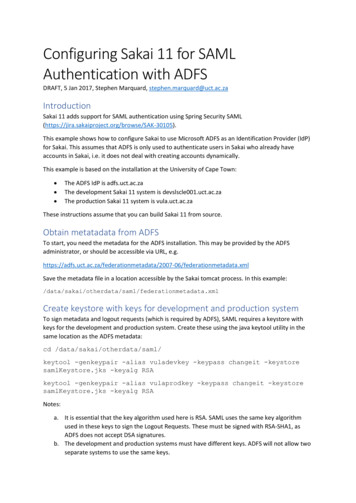


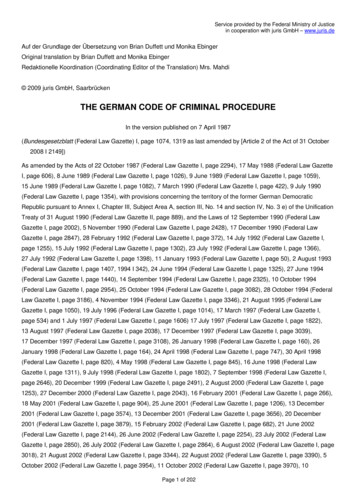
![The Book of the Damned, by Charles Fort, [1919], at sacred .](/img/24/book-of-the-damned.jpg)
